Development of Building Energy Performance Benchmark for Hospitals
Abstract
1. Introduction
2. Overview of the Energy Performance Benchmarking System
2.1. Survey Items and Sampling Method
2.2. Benchmark Development Method
3. Hospital Survey and Analysis
3.1. Survey Design
3.1.1. Survey Items
3.1.2. Sampling
3.1.3. Survey Method
3.2. Survey Result Analysis and Energy Use Key Factors in Survey Result
- -
- Total floor area (m2), R2 = 0.850
- -
- Number of elevators (Unit), R2 = 0.782
- -
- Number of staffed beds (bed), R2 = 0.716
- -
- Number of licensed beds (bed), R2 = 0.699
- -
- Total number of outpatients per year, R2 = 0.645
- -
- Total number of staff, R2 = 0.670
- -
- Number of operating rooms, R2 = 0.624
- -
- Number of MRI, R2 = 0.504
- -
- Total number of inpatients per year, R2 = 0.398
- -
- Number of CT, R2 = 0.347
- -
- Total number of emergency room patients per year, R2 = 0.347
- -
- Total floor area per licensed bed (m2/bed), R2 = 0.284
- -
- Number of buildings in hospital, R2 = 0.249
- -
- Number of X-rays, R2 = 0.191
4. Benchmark Development and Improvement
4.1. Benchmark Development
4.2. Improvement of the Benchmark Model through Test Data
4.3. Energy Performance Assessment by Applying the Improved Benchmark Model
5. Conclusions
Author Contributions
Funding
Institutional Review Board Statement
Informed Consent Statement
Data Availability Statement
Conflicts of Interest
References
- Kim, H.G.; Kim, H.J.; Jeon, C.H.; Chae, M.W.; Cho, Y.H.; Kim, S.S. Analysis of energy saving effect and cost efficiency of ECMs to upgrade the building energy code. Energies 2020, 13, 4955. [Google Scholar] [CrossRef]
- Managan, K.; Araya, M.; Layke, J. Driving Transformation to Energy Efficient Buildings: Policies and Actions; Institute for Building Efficiency: Milwaukee, WI, USA, 2012. [Google Scholar]
- Wang, X.; Feng, W.; Cai, W.; Ren, H.; Ding, C.; Zhou, N. Do residential building energy efficiency standards reduce energy consumption in China?—A data-driven method to validate the actual performance of building energy efficiency standards. Energy Policy 2019, 131, 82–98. [Google Scholar]
- O’Brien, W.; Tahmasebi, F.; Andersen, R.K.; Azar, E.; Barthelmes, V.; Belafi, Z.D.; Berger, C.; Chen, D.; De Simone, M.; Simona d’Oca; et al. An international review of occupant-related aspects of building energy codes and standards. Build. Environ. 2020, 179, 106906. [Google Scholar] [CrossRef]
- Ministry of Land, Infrastructure, and Transport (MOLIT), e-Architectural Information System (e-AIS). Available online: https://cloud.eais.go.kr/ (accessed on 1 October 2022).
- Ministry of Land, Infrastructure, and Transport (MOLIT), Statistics on Buildings. Available online: http://www.molit.go.kr/USR/NEWS/m_71/dtl.jsp?id=95085286/ (accessed on 1 October 2022).
- Ye, Y.; Zuo, W.; Wang, G. A comprehensive review of energy-related data for U.S. commercial buildings. Energy Build. 2019, 186, 126–137. [Google Scholar] [CrossRef]
- Dascalaki, E.G.; Droutsa, K.; Gaglia, A.G.; Kontoyiannidis, S.; Balaras, C.A. Data collection and analysis of the building stock and its energy performance—An example for Hellenic buildings. Energy Build. 2010, 42, 1231–1237. [Google Scholar] [CrossRef]
- Environmental Protection Agency (EPA); Department of Energy (DOE). Energy Star Performance Ratings: Technical Methodology; US Environmental Protection Agency: Washington, DC, USA, 2011.
- Environmental Protection Agency (EPA). Benchmark with EPA’s ENERGY STAR Portfolio Manager. Available online: https://www.energystar.gov/buildings/facility-owners-and-managers/existing-buildings/use-portfolio-manager/ (accessed on 1 October 2022).
- Burman, E.; Hong, S.-M.; Paterson, G.; Kimpian, J.; Mumovic, D. A comparative study of benchmarking approaches for non-domestic buildings: Part 2—Bottom-up approach. Int. J. Sustain. Built Environ. 2014, 3, 247–261. [Google Scholar] [CrossRef]
- Hong, S.M.; Paterson, G.; Burman, E.; Steadman, P.; Mumovic, D. A comparative study of benchmarking approaches for non-domestic buildings: Part 1—Top-down approach. Int. J. Sustain. Built Environ. 2013, 2, 119–130. [Google Scholar] [CrossRef]
- Mathew, P.; Mills, E.; Bourassa, N.; Brook, M. Action-oriented benchmarking: Using the CEUS database to benchmark commercial buildings in California. Energy Eng. 2008, 105, 6–18. [Google Scholar] [CrossRef]
- Wang, S.; Yan, C.; Xiao, F. Quantitative energy performance assessment methods for existing buildings. Energy Build. 2012, 55, 873–888. [Google Scholar] [CrossRef]
- Chung, W. Review of building energy-use performance benchmarking methodologies. Appl. Energy 2011, 88, 1470–1479. [Google Scholar] [CrossRef]
- Luis, P.L.; José, O.; Rocío, G.; Ismael, R.M. A review of benchmarking, rating and labelling concepts within the framework of building energy certification schemes. Energy Build. 2009, 41, 272–278. [Google Scholar]
- Monts, J.K.; Blissett, M. Assessing energy efficiency and energy conservation potential among commercial buildings: A statistical approach. Energy 1982, 7, 861–869. [Google Scholar] [CrossRef]
- Chung, W.; Hui, Y.V.; Lam, Y.M. Benchmarking the energy efficiency of commercial buildings. Appl. Energy 2006, 83, 1–14. [Google Scholar] [CrossRef]
- Dahlan, N.Y.; Mohamed, H.; Kamaluddin, K.A.; Abd Rahman, N.M.; Reimann, G.; Chia, J.; Ilham, N.I. Energy Star based benchmarking model for Malaysian Government hospitals—A qualitative and quantitative approach to assess energy performances. J. Build. Eng. 2022, 45, 103460. [Google Scholar] [CrossRef]
- Department for Communities and Local Government (DCLG). The Government’s Methodology for the Production of Operational Ratings, Display Energy Certificates and Advisory Reports; Communities and Local Government Publications: Wetherby West Yorkshire, UK, 2008.
- Sustainable Energy Authority of Ireland (SEAI): Display Energy Certificate (DEC). Available online: https://www.seai.ie/business-and-public-sector/display-energy-certificate/ (accessed on 1 October 2022).
- Energy Information Agency. Commercial Buildings Energy Consumption Survey. 2018. Available online: https://www.eia.gov/consumption/commercial/ (accessed on 1 October 2022).
- Rodin, C. Energideklaration för John Mattson Fastighets AB: Energibesparing med bibehållen kundkvalitet; Department of Technology and Society, Mälardalens University: Västerås, Sweden, 2011. [Google Scholar]
- Australian Government Department of Industry, Science, Energy and Resources. Commercial Building Disclosure (CBD). Available online: http://cbd.gov.au/ (accessed on 1 October 2022).
- Bundesministerium für Wirtschaft und Energie und Bundesministerium des Innern, für Bau und Heimat. Bekanntmachung der Regeln für Energieverbrauchswerte und der Vergleichswerte im Nichtwohngebäudebestand; Bundesministerium für Wirtschaft und Energie und Bundesministerium des Innern, für Bau und Heimat: Berlin, Germany, 2015. [Google Scholar]
- Bureau of Energy Efficiency. Scheme for Star Rating of Hospital Buildings; Ministry of Power, Government of India Publications: New Delhi, India, 2014.
- Ministry of Land, Infrastructure and Transport (MOLIT). Green Together. Available online: https://www.greentogether.go.kr/ (accessed on 1 October 2022).
- Ministry of Land, Infrastructure and Transport (MOLIT). Building Data Open System. Available online: http://open.eais.go.kr/main/main.do/ (accessed on 1 October 2022).
- Korea Energy Agency (KEA). Energy Audit One-Stop Civil Service. Available online: https://bea.kemco.or.kr/bd/hp/index/ (accessed on 1 October 2022).
- Jung, H.K.; Yu, K.H.; Jeong, Y.S. Energy performance analysis on the design conditions of high-rise apartment houses in South Korea. Adv. Mater. Res. 2014, 1025–1026, 1099–1102. [Google Scholar] [CrossRef]
- Park, D.; Yu, K.; Yoon, Y.; Kim, K.; Kim, S. Analysis of a building energy efficiency certification system in Korea. Sustainability 2015, 7, 16086–16107. [Google Scholar] [CrossRef]
- Jain, N.; Burman, E.; Stamp, S.; Shrubsole, C.; Bunn, R.; Oberman, T.; Barrett, E.; Aletta, F.; Kang, J.; Raynham, P.; et al. Building performance evaluation of a new hospital building in the UK: Balancing indoor environmental quality and energy performance. Atmosphere 2021, 12, 115. [Google Scholar] [CrossRef]
- Vaziri, S.M.; Rezaee, B.; Monirian, M.A. Utilizing renewable energy sources efficiently in hospitals using demand dispatch. Renew. Energy 2020, 151, 551–562. [Google Scholar] [CrossRef]
- American Hospital Association (AHA). AHA Annual Survey Database. Available online: https://www.ahadata.com/aha-annual-survey-database/ (accessed on 1 October 2022).
- American Society for Healthcare Engineering (ASHE). ASHE: Energy & Water Survey. Available online: www.ashe.org/energysurvey/ (accessed on 1 October 2022).
- Korea Energy Economics Institute; Korea Energy Agency. 2016 Energy Consumption Survey; Ministry of Trade, Industry and Energy (MTIE): Sejong, Korea, 2017. [Google Scholar]
- Trost, J.E. Statistically nonrepresentative stratified sampling: A sampling technique for qualitative studies. Qual. Sociol. 1986, 9, 54–57. [Google Scholar] [CrossRef]
- Singer, B.C. Hospital Energy Benchmarking Guidance-Version 1.0 (No. LBNL-2738E); Lawrence Berkeley National Lab. (LBNL): Berkeley, CA, USA, 2009. [Google Scholar]
- Sheppy, M.; Pless, S.; Kung, F. Healthcare Energy End-Use Monitoring (No. NREL/TP-5500-61064); National Renewable Energy Lab. (NREL): Golden, CO, USA, 2014. [Google Scholar]
- The Chartered Institution of Building Services Engineers (CIBSE). Energy Benchmarks CIBSE TM46; CIBSE: London, UK, 2008. [Google Scholar]
- Korean Hospital Association (KHA). 2016 List of Hospitals; Korean Hospital Association (KHA): Seoul, Korea, 2017. [Google Scholar]
- Myers, J.L.; Well, A.D.; Lorch, R.F., Jr. Research Design and Statistical Analysis; Routledge: London, UK, 2013. [Google Scholar]
- Scheaffer, W.; Mendenhall, R.L., III; Ott, K.G. Gerow, Elementary Survey Sampling; Cengage Learning: Mason, OH, USA, 2011. [Google Scholar]
- Ihaka, R.; Gentleman, R. R: A Language for Data Analysis and Graphics. J. Comput. Graph. Stat. 1996, 5, 299–314. [Google Scholar]
- Thompson, B. Stepwise regression and stepwise discriminant analysis need not apply here: A guidelines editorial. Educ. Psychol. Meas. 1995, 55, 525–534. [Google Scholar] [CrossRef]
- Environmental Protection Agency (EPA). ENERGY STAR Performance Ratings Technical Methodology; US Environmental Protection Agency: Washington, DC, USA, 2010.
- Environmental Protection Agency (EPA). ENERGY STAR Performance Ratings Technical Methodology for Hospital (General Medical and Surgical); US Environmental Protection Agency: Washington, DC, USA, 2011.
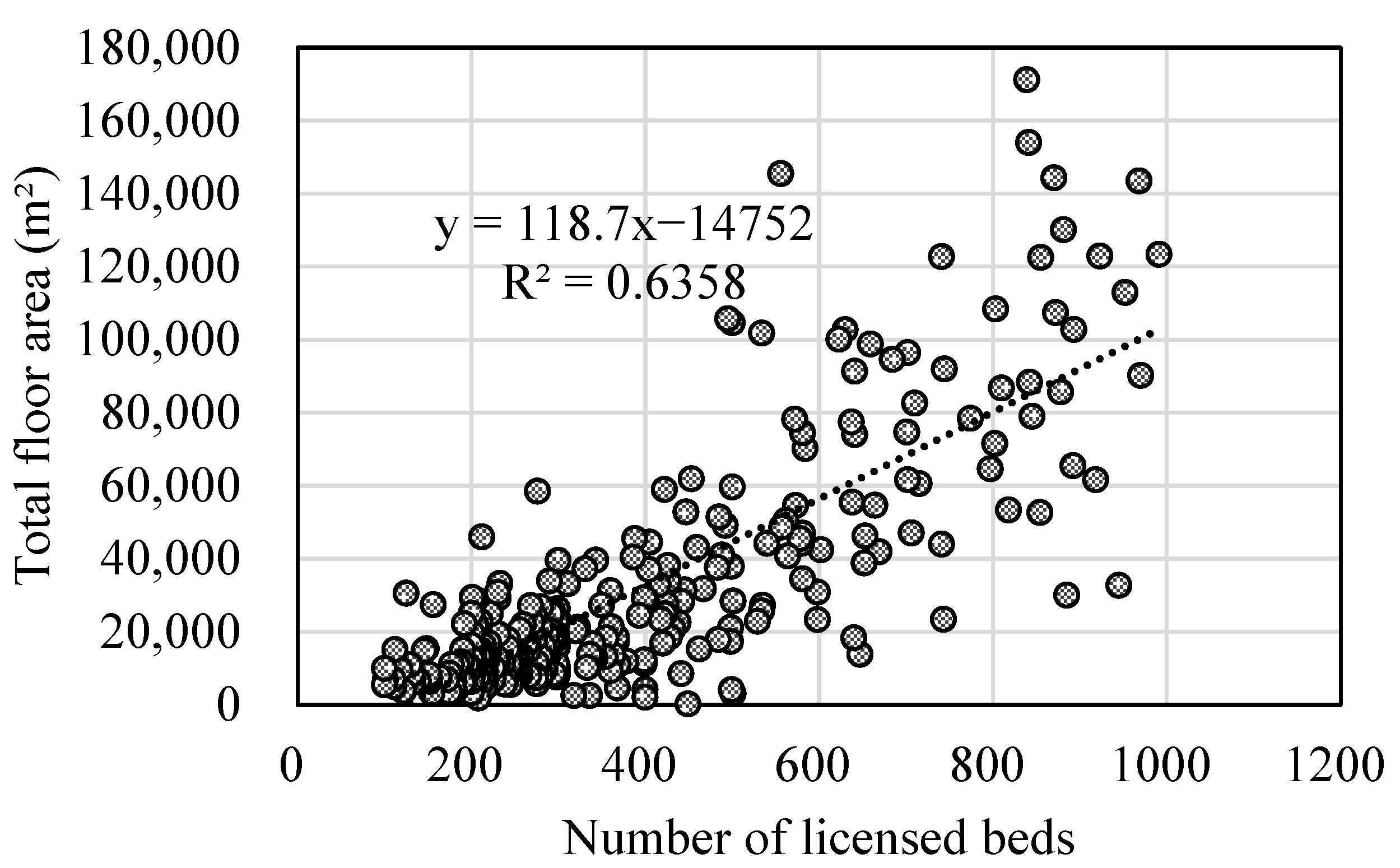
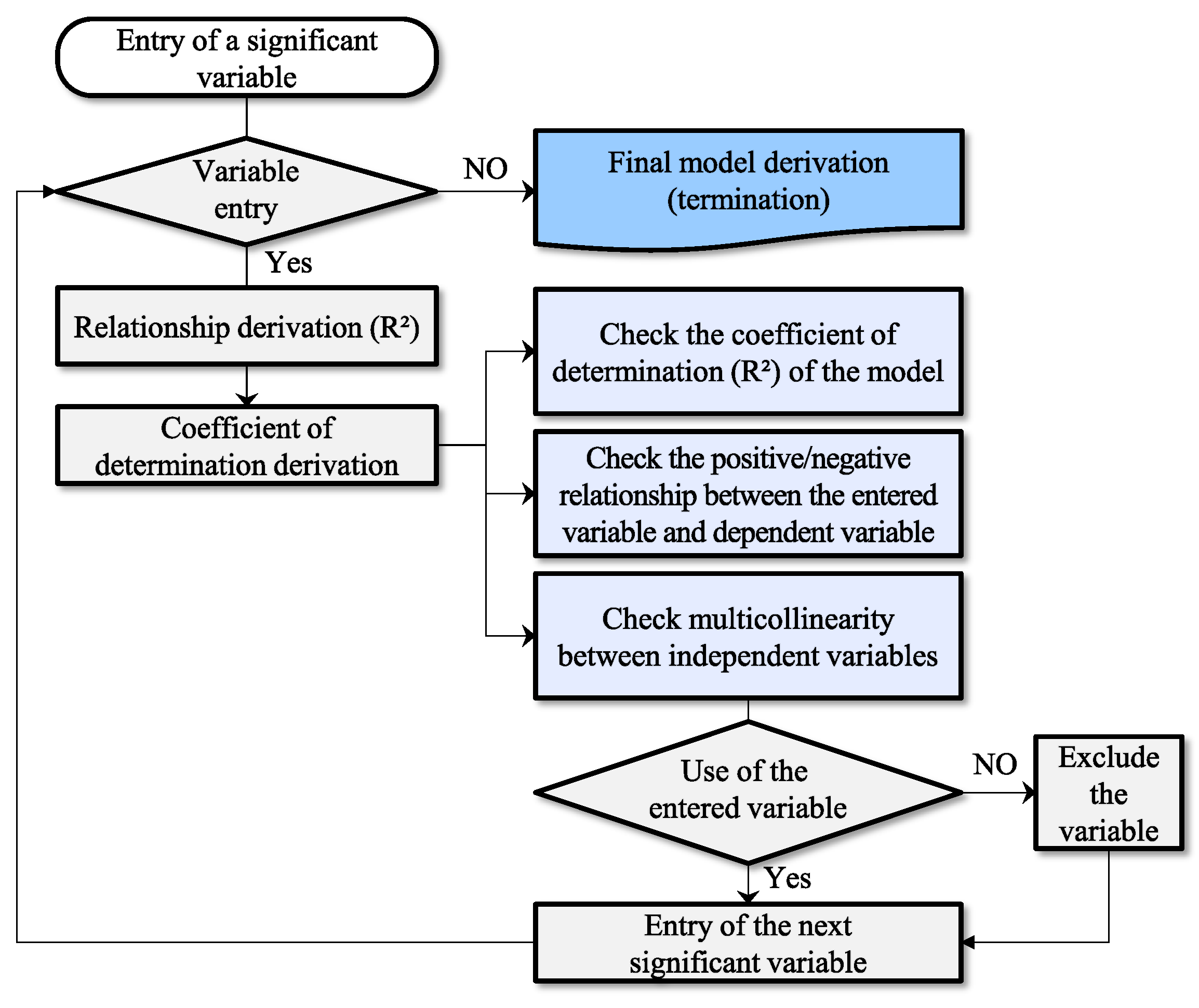
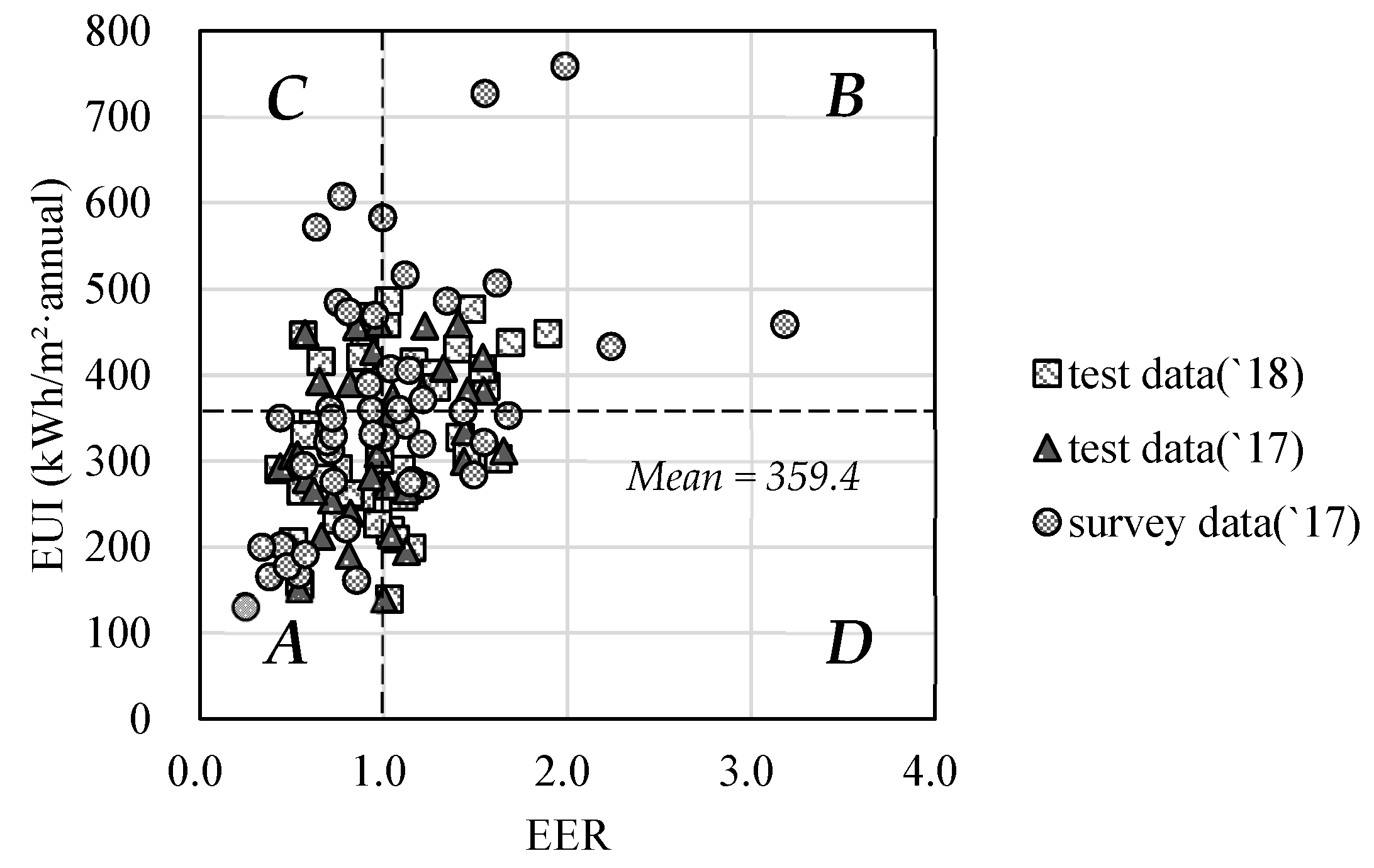
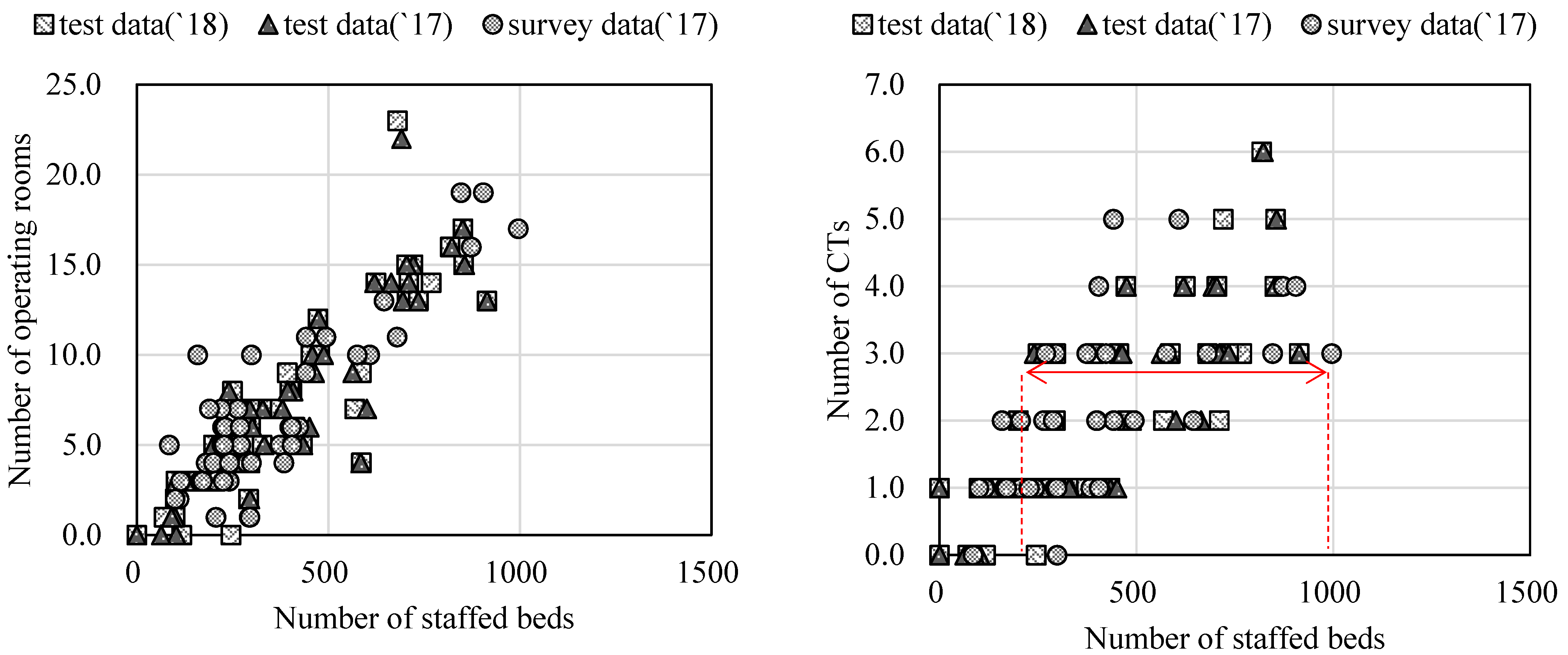

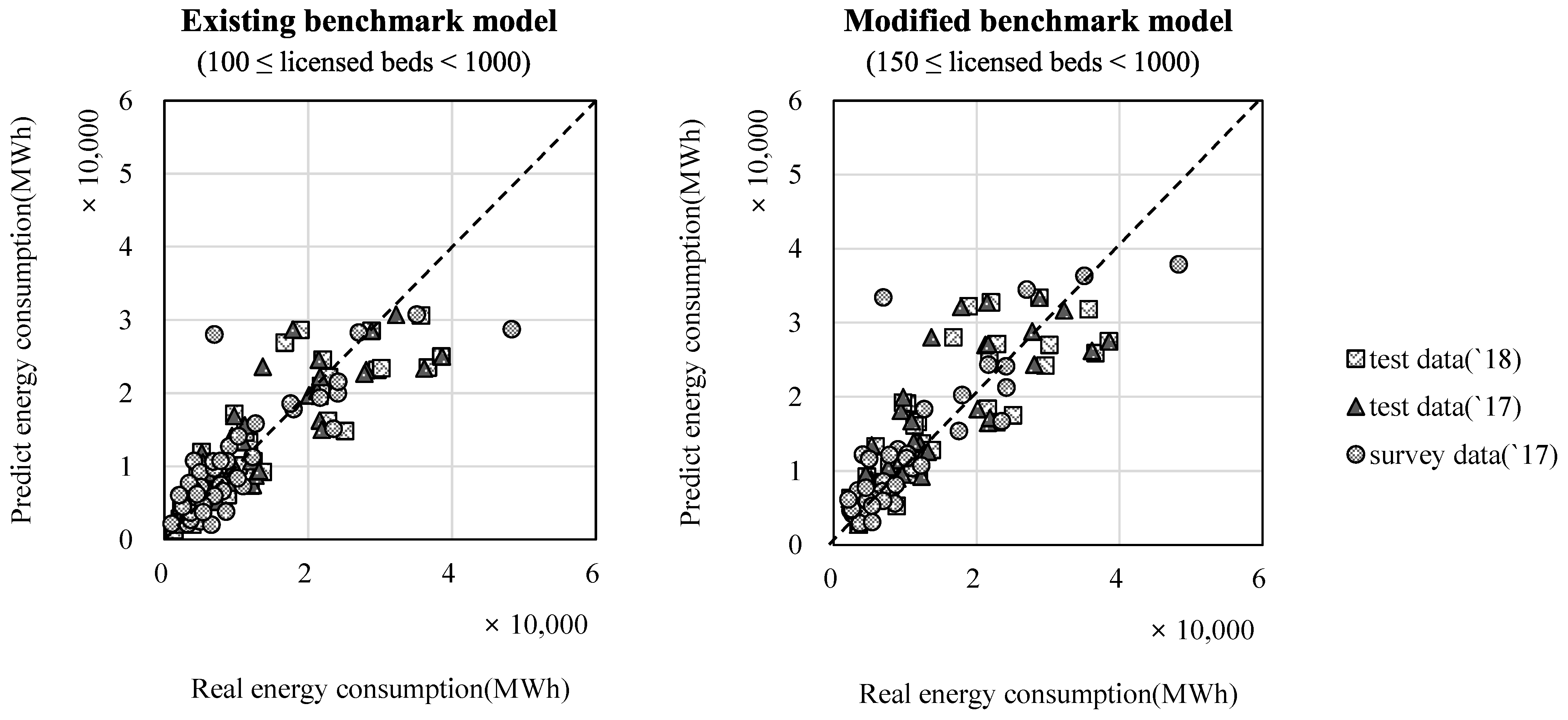

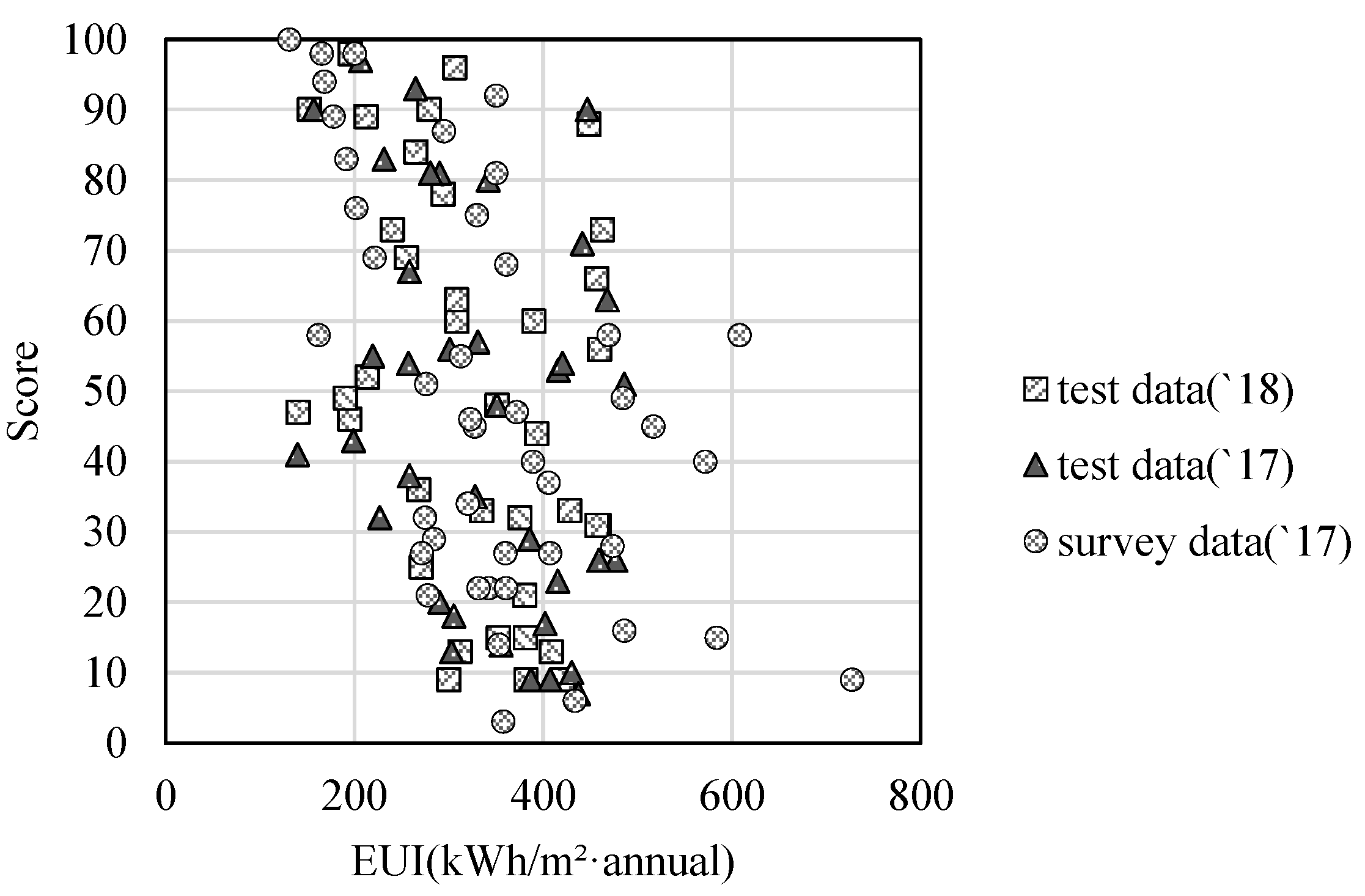
| Country | No. | Survey or System Name | Type * |
|---|---|---|---|
| U.S. | 1 | Commercial Building Energy Consumption Survey (CBECS) [22] | A |
| 2 | EnergyStar (Portfolio Manager) [9,10] | B | |
| 3 | American Hospital Association (AHA) Survey [34] | A | |
| 4 | American Society for Healthcare Engineering (ASHE): Energy & Water Survey [35] | A | |
| Germany | 5 | Verbrauchsausweis [25] | B |
| India | 6 | Building Energy Efficiency (BEE) Star Rating [26] | B |
| Korea | 7 | Energy Consumption Survey [36] | A |
| 8 | National Building Energy Database (NBED) [27,28] | A |
| Category | Survey Item | 1 | 2 | 3 | 4 | 5 | 6 | 7 | 8 | |||
|---|---|---|---|---|---|---|---|---|---|---|---|---|
| Hospital information | General information | Name, Address | ● | ● | ● | ● | ● | ● | ● | ● | ||
| Heating/cooling degree days | ● | ● | ● | ● | ||||||||
| Built/opening year | ● | ● | ● | |||||||||
| Hospital type (public/private) | ● | ● | ● | |||||||||
| Survey respondents’ information | ● | ● | ● | |||||||||
| Building management method | ● | |||||||||||
| Number of buildings in institutions | ● | ● | ● | ● | ||||||||
| Total floor area/Total floor area above the ground | ● | ● | ● | ● | ● | ● | ● | ● | ||||
| Retrofit | Retrofit history | ● | ||||||||||
| Business activity | Operation | Number of beds (licensed, staffed) | ● | ● | ● | ● | ● | |||||
| Bed operation rate | ● | |||||||||||
| Number of operating rooms | ● | ● | ● | |||||||||
| Occupancy | Total number of staff | ● | ● | ● | ● | |||||||
| Total number of inpatients (or) outpatients | ● | ● | ● | |||||||||
| Number of regular/temporary workers | ● | ● | ● | ● | ||||||||
| Equipment for business activity | Number of medical equipment (e.g., MRI and CT.) | ● | ● | ● | ||||||||
| Features of individual building | Basic information | Name of each building | ● | ● | ● | ● | ||||||
| Building geometry | ● | |||||||||||
| Building orientation | ● | |||||||||||
| Building height | ● | ● | ||||||||||
| Floors above the ground, basement floors, total floors | ● | ● | ● | ● | ||||||||
| Area | Total floor area | ● | ● | ● | ● | ● | ||||||
| Ratio of medical area | ● | ● | ||||||||||
| Space ratio for medical service | ● | ● | ||||||||||
| Parking area in building | ● | ● | ||||||||||
| Envelope | Window-to-wall ratio (WWR) | |||||||||||
| Exterior wall/roof/windows thermal transmittance | ● | |||||||||||
| Equipment | Heating and cooling production | System | Main heating/cooling system | ● | ● | |||||||
| Source | Main heating/cooling energy source | ● | ● | ● | ||||||||
| System control | Operating days of heating/cooling system | ● | ||||||||||
| Operating times of heating/cooling system | ● | |||||||||||
| Heating/cooling set temperature | ● | |||||||||||
| Automatic control | BAS (Building Automation System) and EMCS (Energy Management Control System) information | ● | ● | |||||||||
| Emergency power system | Emergency power system (UPS capacity, emergency generator) | ● | ||||||||||
| HVAC | Type of HVAC system | ● | ● | |||||||||
| Hot water | Hot water system | |||||||||||
| Transport | Elevator, escalator etc. | ● | ● | |||||||||
| Lighting | Application rate of LED in buildings | ● | ● | |||||||||
| Lighting control methods | ● | |||||||||||
| Energy consumption | Metering | Metering methods (each building or whole building) | ● | ● | ● | |||||||
| Utility bills | Monthly or annual energy consumption | ● | ● | ● | ● | ● | ● | ● | ● | |||
| Country | Name | Population | Sample List | Sample Design | Stratification Variables | Distribution |
|---|---|---|---|---|---|---|
| U.S. | Commercial Building Energy Survey (CBECS) [22] | Commercial buildings | List of commercial buildings in the CBECS survey area | Stratified sampling | Area Administrative district Number of commercial buildings in the block | Probability proportional to size (PPS) |
| England | Display Energy Certificate (DEC) [20,21] | Non-residential buildings | DEC database, CaRB2 model—UCL, etc. | Detailed use and total floor area | PPS | |
| Korea | Energy Consumption Survey [36] | Nationwide buildings | Census on establishments and population housing census. | Subdivision of businesses to small and medium sizes and the number of employees | Compromised allocation |
| Category | UK | Ireland | Sweden | USA | Australia | |
|---|---|---|---|---|---|---|
| System Overview | System name | DEC [20] | DEC [21] | Energideklaration [23] | Energy Star [9,10] | CBD [24] |
| Implementation entity | Department of Energy and Climate Change | Sustainable Energy Authority of Ireland | Ministry of Enterprise, Ministry of Environment | Environment Protection Agency | Department of Resources, Energy and Tourism | |
| Target Building | Building type | Existing/public | Existing/public | New/existing | Existing | Existing |
| Building use | Non-residential | Non-residential | Residential/non-residential | Residential/non-residential | Commercial | |
| Benchmark development method | Assessment item | CO2 emissions | Primary energy consumption | Final energy consumption (before 2019), primary energy consumption (from January 2019) | Primary energy consumption | CO2 emissions |
| Indicator type (calculation method) | Statistics (median by building use) | Statistics (median by building use) | Absolute value (based on new buildings) | Statistics (predicted primary energy consumption) | Statistics (average by building use) | |
| Normalization variable | Heating degree days, operating time | Heating degree days, operating time | Climate (51 classifications) | Cooling/heating degree days, business activity-related variables | Climate, operating time, total floor area, equipment density | |
| Normalization method | Calibration formula | Calibration formula | Calibration factor | Regression equation (regression coefficient) | Calibration factor | |
| Normalization target | Benchmark | Benchmark | Actual energy consumption | Benchmark | Benchmark and actual energy consumption | |
| Category | Sub-Category | Survey Item | Unit |
|---|---|---|---|
| Part 1 Total hospital | General information | Hospital name | - |
| Address of hospital | - | ||
| Survey respondents’ information | - | ||
| Number of buildings in institutions (hospital) | - | ||
| Total floor area (TFA) | m2 | ||
| TFA above the ground | m2 | ||
| Building use period (year) | Years | ||
| Building management method | - | ||
| Retrofit | Retrofit history | - | |
| Business activity | Number of workers (staff) | - | |
| Total number of inpatients per year | - | ||
| Total number of outpatients per year | - | ||
| Total number of emergency patients per year | - | ||
| M&E information | Number of operating rooms | - | |
| Number of MRI | - | ||
| Number of CT | - | ||
| Number of X-ray | - | ||
| Number of PET | - | ||
| Number of licensed beds | - | ||
| Number of staffed beds | - | ||
| Bed operation rate | % | ||
| Part 2 Operating department | General information | Area by operating department (e.g., outpatient department and inpatient department.) | m2 |
| Area ratio to total floor area | % | ||
| Equipment operation | Set-point temperature by operating department | °C | |
| Heating/cooling days by operating department | Days/year | ||
| Heating/cooling times by operating department | h/day | ||
| Part 3 Individual building | Building | Exterior wall thermal transmittance | W/m2K |
| Roof thermal transmittance | W/m2K | ||
| Windows thermal transmittance | W/m2K | ||
| Equipment | Main heating/cooling system | - | |
| Main heating/cooling source | - | ||
| Hot water source | - | ||
| HVAC system | - | ||
| Number of elevators | - | ||
| Application rate of LED in buildings | % |
| Class | 100–200 | 200–300 | 300–400 | 400–500 | 500–600 | 600–700 | 700–800 | 800–900 | 900–1000 | Total |
|---|---|---|---|---|---|---|---|---|---|---|
| Population | 40 | 133 | 33 | 36 | 24 | 16 | 13 | 20 | 8 | 323 |
| Percentage (%) | 12 | 41 | 10 | 11 | 7 | 5 | 4 | 6 | 2 | 100 |
| Class | 100–200 | 200–300 | 300–400 | 400–500 | 500–600 | 600–700 | 700–800 | 800–900 | 900–1000 | Total |
|---|---|---|---|---|---|---|---|---|---|---|
| Population | 40 | 133 | 33 | 36 | 24 | 16 | 13 | 20 | 8 | 323 |
| Minimum required sample size | 7 | 23 | 6 | 6 | 4 | 3 | 2 | 3 | 1 | 56 |
| Planned sample | 12 | 41 | 10 | 11 | 7 | 5 | 4 | 6 | 2 | 100 |
| Surveyed sample | 7 | 23 | 4 | 5 | 2 | 3 | 0 | 2 | 2 | 48 |
| Category | Independent Variables | Freq. | Mean | Average by Number of Beds | Dependent Variable | |||||
|---|---|---|---|---|---|---|---|---|---|---|
| 100–300 Beds | 300–500 Beds | Over 500 Beds | Total Energy Consumption per Year (MWh) | Total Energy Consumption per Total Floor Area (kWh/m2) | ||||||
| n= 30 | n = 9 | n = 9 | Coeff. | R2 | Coeff. | R2 | ||||
| General information | Building use period (year) | 48 | 21.1 | 20.8 | 25.4 | 17.7 | −98.8 | 0.016 | 2.37 | 0.040 |
| Total floor area (m2) | 48 | 28,569 | 14,783 | 32,789 | 70,301 | 0.343 *** | 0.850 *** | −0.001 | 0.018 | |
| Total floor area per licensed bed (m2/bed) | 48 | 74.0 | 66.6 | 78.5 | 93.9 | 180.6 *** | 0.284 *** | −0.968 | 0.036 | |
| Number of licensed beds (bed) | 48 | 360.2 | 225.8 | 421.3 | 747.0 | 36.0 *** | 0.699 *** | −0.074 | 0.013 | |
| Number of staffed beds (bed) | 47 | 346.0 | 210.6 | 408.0 | 735.9 | 35.9 *** | 0.716 *** | −0.061 | 0.009 | |
| Bed operation rate (%) | 48 | 83.3 | 82.7 | 83.1 | 85.8 | 78.5 | 0.006 | −3.11 | 0.041 | |
| M&E information | Application rate of LED in buildings (%) | 48 | 52.4 | 53.8 | 53.2 | 47.1 | −5801 | 0.031 | −16.4 | 0.001 |
| Number of elevator (Unit) | 48 | 8.2 | 5.2 | 10.2 | 16.3 | 1377 *** | 0.782 *** | −1.02 | 0.002 | |
| Architectural information | Number of buildings in hospital | 48 | 2.4 | 1.8 | 3.4 | 3.6 | 2500 *** | 0.249 *** | −0.000 | 0.005 |
| Roof thermal transmittance (W/m2K) | 48 | 0.4 | 0.3 | 0.4 | 0.3 | −3120 | 0.001 | 343.5 | 0.064 | |
| Exterior wall thermal transmittance (W/m2K) | 48 | 0.5 | 0.5 | 0.5 | 0.5 | 2870 | 0.000 | 97.1 | 0.003 | |
| Windows thermal transmittance (W/m2K) | 48 | 2.8 | 2.6 | 2.4 | 3.8 | 8610 | 0.288 | 1.8 | 0.000 | |
| Operating information | Total number of staff | 48 | 660.9 | 358.2 | 794.7 | 1536 | 14.7 *** | 0.670 *** | −0.004 | 0.000 |
| Total number of emergency room patients per year | 48 | 21,945 | 15,183 | 25,741 | 40,687 | 0.350 *** | 0.347 *** | 0.000 | 0.000 | |
| Total number of outpatients per year | 48 | 342,016 | 198,733 | 366,074 | 795,566 | 0.026 *** | 0.645 *** | −0.000 | 0.013 | |
| Total number of inpatients per year | 48 | 86,552 | 42,786 | 88,468 | 230,521 | 0.061 *** | 0.398 *** | −0.000 | 0.001 | |
| Number of operating rooms | 48 | 6.5 | 4.3 | 6.4 | 14 | 1649 *** | 0.624 *** | 1.92 | 0.004 | |
| Number of MRI | 48 | 1.6 | 1.2 | 1.7 | 2.7 | 8125 *** | 0.504 *** | 22.6 | 0.017 | |
| Number of CT | 48 | 1.8 | 1.2 | 2.6 | 3.2 | 4586 *** | 0.347 *** | −11.6 | 0.010 | |
| Number of X-ray | 48 | 7.6 | 4.7 | 11.9 | 13.1 | 585 ** | 0.191 ** | 0.377 | 0.000 | |
| Energy consumption | Total energy consumption per year (MWh) | 48 | 9800 | 4912 | 11,714 | 24,178 | - | - | 0.003 | 0.035 |
| Total energy consumption per total floor area (kWh/m2) | 48 | 359.4 | 365.3 | 356.4 | 343.0 | 12.4 | 0.035 | - | - | |
| Total energy consumption per licensed bed (kWh/bed) | 48 | 25,851 | 32,834 | 28,382 | 31,998 | 0.437 *** | 0.333 *** | - | - | |
| Total energy consumption per staffed bed (kWh/bed) | 47 | 27,506 | 23,407 | 27,852 | 32,484 | 0.370 *** | 0.257 *** | - | - | |
| Category | Variable | Type | Freq. | Ratio | Average of EUI * | Category | Variable | Type | Freq. | Ratio | Average of EUI |
|---|---|---|---|---|---|---|---|---|---|---|---|
| General information | Hospital type | Private | 40 | 83% | 343.1 | M&E information | HVAC system | Central | 26 | 54% | 370.3 |
| Public | 8 | 17% | 441.0 | Individual | 13 | 27% | 345.9 | ||||
| Total | 48 | 100% | - | Mixed | 5 | 10% | 337.0 | ||||
| Hospital size | Under 300 beds | 30 | 63% | 356.5 | No AHU | 4 | 8% | 361.0 | |||
| Over 300 beds | 18 | 38% | 364.3 | Total | 48 | 100% | - | ||||
| Total | 48 | 100% | - | Main heating source | Gas (LNG) | 29 | 60% | 363.5 | |||
| M&E information | Main heating system | Absorption chiller–heater | 18 | 38% | 368.4 | Electricity | 13 | 27% | 369.1 | ||
| District heating | 5 | 10% | 316.7 | ||||||||
| Steam boiler | 11 | 23% | 370.3 | LPG | 1 | 2% | 329.4 | ||||
| EHP | 8 | 17% | 342.7 | Total | 48 | 100% | - | ||||
| District heating | 5 | 10% | 316.7 | Main cooling source | Gas (LNG) | 25 | 52% | 357.3 | |||
| Others | 6 | 13% | 370.3 | Electricity | 22 | 46% | 369.1 | ||||
| Total | 48 | 100% | - | District heating | 1 | 2% | 200.1 | ||||
| Main cooling system | Absorption chiller–heater | 19 | 40% | 373.5 | Total | 48 | 100% | - | |||
| Hot water source | Gas (LNG) | 38 | 79% | 365.0 | |||||||
| Absorption chiller | 11 | 23% | 352.7 | Electricity | 5 | 10% | 364.1 | ||||
| District heating | 4 | 8% | 308.3 | ||||||||
| EHP | 11 | 23% | 340.3 | LPG | 1 | 2% | 329.4 | ||||
| Others | 7 | 15% | 361.8 | Total | 48 | 100% | - | ||||
| Total | 48 | 100% | - |
| Step | Contents | ||||
|---|---|---|---|---|---|
| 1 | Independent variable | Heating/cooling degree days, number of buildings, total floor area, area for floor area ratio calculation | Number of operating rooms, number of beds (licensed and operating), number of workers ** | Number of emergency patients per year **, number of outpatients per year **, number of inpatients per year **, bed operation rate | Number of MRI *, number of PT *, number of PET *, number of X-rays *, number of imaging devices * |
| 2 | Dependent variable | Final energy consumption (total amount in 2017, MWh) | |||
| 3 | Multiple regression analysis (step input, N = 48): Considering independent variable collinearity/significance judgment (statistical examination) and whether the model is understood by hospital stakeholders | ||||
| 4 | R2 examination | R2 = 0.86 (86%) | |||
| 5 | Model derivation | Predicted energy (MWh) = 13.187 (V1 − 346) + 770.862 (V2 − 6.5) + 1665.844 (V3 − 1.8) + 10,033.81 V1: Number of staffed beds V2: Number of operating rooms V3: Number of CT | |||
| Class | 100–200 | 200–300 | 300–400 | 400–500 | 500–600 | 600–700 | 700–800 | 800–900 | 900–1000 | Total |
|---|---|---|---|---|---|---|---|---|---|---|
| Population | 40 | 133 | 33 | 36 | 24 | 16 | 13 | 20 | 8 | 323 |
| Surveyed sample | 7 | 23 | 4 | 5 | 2 | 3 | 0 | 2 | 2 | 48 |
| Pilot assessment | 3 | 13 (4)* | 4 (1)* | 5 (1)* | 4 (1)* | 3 | 3 | 6 | 0 | 41 (7)* |
| Surveyed + pilot assessment | 10 | 32 | 7 | 9 | 5 | 6 | 3 | 8 | 2 | 82 |
| Hospital Name | Number of Staffed Beds | Number of Operating Rooms | CT | EUI | EER |
|---|---|---|---|---|---|
| Hospital A | 240 | 8 | 3 | 291 | 0.44 |
| Hospital B | 394 | 8 | 1 | 306 | 0.50 |
| Hospital C | 284 | 7 | 1 | 152 | 0.54 |
| Hospital D | 295 | 2 | 1 | 196 | 0.48 |
| Hospital E | 333 | 5 | 1 | 312 | 1.65 |
| Existing Benchmark Model | Modified Benchmark Model | |
|---|---|---|
| Number of observations | 48 | 43 |
| Independent variables | Number of staffed beds (V1) Number of operating rooms (V2) Number of CT (V3) | Number of staffed beds (V1) Number of operating rooms (V2) |
| Model equation | 13.187 (V1 − 346) + 770.862 (V2 − 6.5) + 1665.844 (V3 − 1.8) + 10,033.81 | 31.245 (V1 − 360) + 644.764 (V2 − 7) + 10,621.697 |
| R2 | 0.86 | 0.86 |
| Application target | Hospitals with more than 100 beds and less than 1000 beds | Hospitals with more than 150 beds and less than 1000 beds |
| Score | Cumulative Percentage (%) | EER | Score | Cumulative Percentage (%) | EER | ||
|---|---|---|---|---|---|---|---|
| < | < | ||||||
| 100 | 0 | 0.000 | 0.278 | 89 | 11 | 0.492 | 0.504 |
| 99 | 1 | 0.278 | 0.323 | 88 | 12 | 0.504 | 0.516 |
| 98 | 2 | 0.323 | 0.354 | 87 | 13 | 0.516 | 0.527 |
| 97 | 3 | 0.354 | 0.379 | 86 | 14 | 0.527 | 0.538 |
| 96 | 4 | 0.379 | 0.400 | 85 | 15 | 0.538 | 0.548 |
| 95 | 5 | 0.400 | 0.419 | 84 | 16 | 0.548 | 0.559 |
| 94 | 6 | 0.419 | 0.436 | 83 | 17 | 0.559 | 0.569 |
| 93 | 7 | 0.436 | 0.451 | 82 | 18 | 0.569 | 0.578 |
| 92 | 8 | 0.451 | 0.465 | 81 | 19 | 0.578 | 0.588 |
| 91 | 9 | 0.465 | 0.479 | 80 | 20 | 0.588 | 0.634 |
| 90 | 10 | 0.479 | 0.492 | 40 | 60 | 0.931 | 0.941 |
Disclaimer/Publisher’s Note: The statements, opinions and data contained in all publications are solely those of the individual author(s) and contributor(s) and not of MDPI and/or the editor(s). MDPI and/or the editor(s) disclaim responsibility for any injury to people or property resulting from any ideas, methods, instructions or products referred to in the content. |
© 2022 by the authors. Licensee MDPI, Basel, Switzerland. This article is an open access article distributed under the terms and conditions of the Creative Commons Attribution (CC BY) license (https://creativecommons.org/licenses/by/4.0/).
Share and Cite
Kim, H.G.; Jeong, D.W.; Kwon, S.J.; Kim, S.S. Development of Building Energy Performance Benchmark for Hospitals. Buildings 2023, 13, 12. https://doi.org/10.3390/buildings13010012
Kim HG, Jeong DW, Kwon SJ, Kim SS. Development of Building Energy Performance Benchmark for Hospitals. Buildings. 2023; 13(1):12. https://doi.org/10.3390/buildings13010012
Chicago/Turabian StyleKim, Hye Gi, Da Woon Jeong, Soon Jung Kwon, and Sun Sook Kim. 2023. "Development of Building Energy Performance Benchmark for Hospitals" Buildings 13, no. 1: 12. https://doi.org/10.3390/buildings13010012
APA StyleKim, H. G., Jeong, D. W., Kwon, S. J., & Kim, S. S. (2023). Development of Building Energy Performance Benchmark for Hospitals. Buildings, 13(1), 12. https://doi.org/10.3390/buildings13010012







